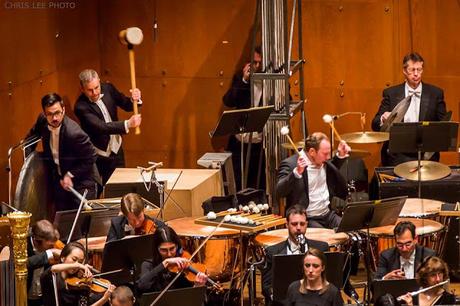by Paul J. Pelkonen

Members of the New York Philharmonic brace for impact as Daniel Druckman
(with hammer) delivers the death blow during the Mahler Sixth. Photo by Chris Lee.
Mr. van Zweden, who is winding up his first season at the helm of the Philharmonic, was forced to withdraw, on doctor's orders from this week's performances of the Mahler Sixth. According to a Philharmonic press release, the maestro suffered a "serious" second degree burn on his left shoulder while applying an ice therapy treatment to the afflicted joint. He is expected to make a full and complete recovery.
He will thus be sitting out this week's concert. The Philharmonic has announced that his replacement is the Australian conductor Simone Young. Her colorful podium career has had her break new ground in Germany and Austria. She led the Hamburg Philharmonic in a complete cycle of the ten Wagner repertory operas and is the first female conductor to be invited to lead the Vienna State Opera. This is her first appearance with the Philharmonic since her debut with the orchestra in 1998.
The Sixth is widely considered to be Mahler's darkest symphony. Cast in the conventional four movements, it is the only one of Mahler's symphonies to remain grimly, even stubbornly in the minor key. The first movement is a rampaging march, a determined thrust forward that presents a heroic figure making progress against impossible odds. That progress is occasionally interrupted for one of Mahler's most lyric themes, a love-note to his wife Alma.
This week's Philharmonic performances will follow the original order of movements chosen by Mahler, with the Scherzo movement placed before the Andante. (Mahler later revised the work, flipping the order of the movements, but the choice is ultimately left to the discretion of the conductor.)
Although Mahler himself was music director of the New York Philharmonic for two years, difficulties with getting his own music performed in New York meant that he never managed to conduct this work with the orchestra. The Philharmonic premiere of the Sixth was given in 1947 by Dmitri Mitropoulos.
The famous effect of the hammer (achieved with a giant wooden mallet striking a wooden box) occurs in the last movement. It represents a "blow of fate" that fells the "hero" of the symphony in his tracks, putting an end to his determined forward progress and literally interrupting the entire orchestra. Each blow is dictated to be played at a particular moment in the score and must be precisely delivered, as it comes in unison with a crash of timpani, gong and cymbals.
Mahler originally planned for three hammer-blows in the symphony but later revised it to just two. However, the blows would play out in his own life as the composer suffered a series of shattering personal tragedies. His younger daughter died. His career at the helm of the Vienna State Opera was shortened due to political infighting in that city. He resigned and moved to New York City, where he led both the Metropolitan Opera and the New York Philharmonic for several seasons. And then the third blow of fate: his doctor informed him that he had a congenital heart defect. Mahler died in 1911 at the age of 51.
If you enjoyed this article, it's time to click over to Superconductor's Patreon page, and help support the cost of independent music journalism in New York City at the low cost of just $5/month.

